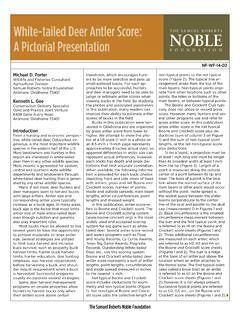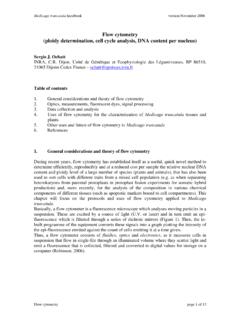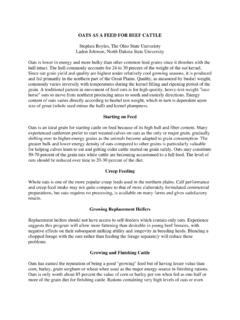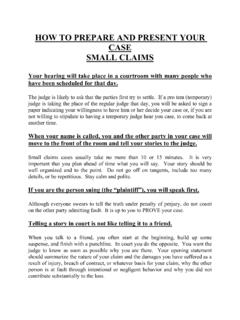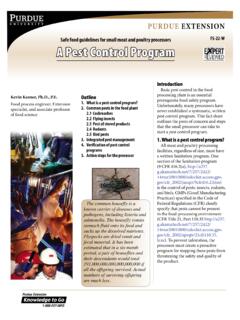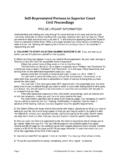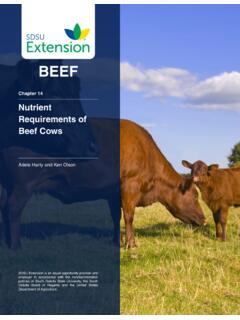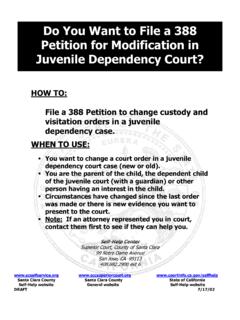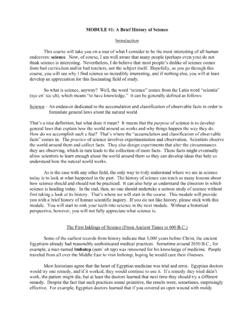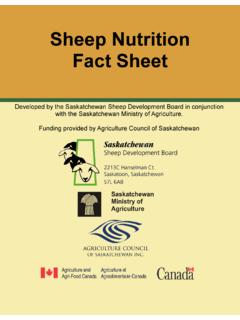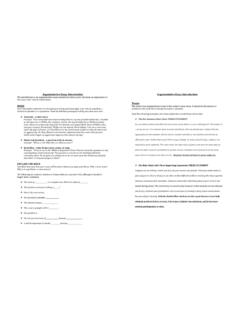Transcription of The Carbon Cycle - Noble
1 Noble Research Institute, LLC 2510 Sam Noble Parkway Ardmore, OK 73401 580-223-5810An education and outreach program of:TEACHER GUIDELESSON OVERVIEW:The Carbon Cycle is the biogeochemical Cycle by which Carbon is exchanged among the biosphere, pedosphere, geosphere, hydro-sphere and atmosphere of Earth. Along with the nitrogen Cycle and the water Cycle , the Carbon Cycle comprises a sequence of events key to making Earth capable of sustaining life; it describes the movement of Carbon as it is recycled and reused throughout the OBJECTIVES:Students will be able to:1. Observe the density of Carbon Demonstrate the effect of temperature on the amount of car-bon dioxide that will dissolve in water. 3. Test the effect of Carbon dioxide on the pH of Describe how these properties of Carbon dioxide relate to the Carbon Cycle . ESSENTIAL QUESTION:How does matter Cycle through an ecosystem?
2 TOPICAL ESSENTIAL QUESTION:What is Carbon s role in life on Earth?TOTAL DURATION:15-20 min. pre-lab prep time; 40-50 min. class timeSAFETY PRECAUTIONS: Avoid contact of all chemicals with eyes and skin. Wear safety glasses, lab coat and gloves when performing the experiment. Universal indicator is flammable and is a mild eye and skin irritant. Baking soda and vinegar are not considered hazardous. Howev-er, prudent safety procedures should always be observed when handling chemicals in the laboratory. Dry ice is extremely cold and can quickly freeze skin; avoid con-tact with skin. Use caution when handling hot water. Do not eat, drink or chew gum while in the laboratory. Wash hands thoroughly with soap and water before leaving the PER GROUP:Activity 1 Carbonated water (clear soda or seltzer water) Hot water (50 C) Cold water (5 C) Two 12 oz.
3 Plastic bowls Two small (3 oz.) clear plastic cups Activity 2 Vinegar Baking soda Universal indicator Water Water and indicator cup Baking soda and vinegar Mini spoon Universal indicator pH color chartActivity 3 Bubble generator* Dry ice (8 oz.) 9 oz. plastic cup Water (enough to fill bubble generator half-full) Plastic spoon Dish soap (5 mL) Cotton glove*A bubble generator can be purchased from Steve Spangler, or a homemade one can be built from simplet materials ( , plastic pickle jar or large plastic container and rub-ber tubing). THE Carbon CYCLEAn education and outreach program of:TEACHER GUIDEN oble Research Institute, LLC 2510 Sam Noble Parkway Ardmore, OK 73401 580-223-5810 THE Carbon CYCLESTANDARDS: Science and Engineering Practices:1. Asking questions 2. Developing and using models 3. Planning and carrying out investigations 4.
4 Analyzing and interpreting data5. Using mathematics and computational thinking 6. Constructing explanations and designing solutions 7. Engaging in argument from evidence 8. Obtaining, evaluating and communicating evidence Crosscutting Concepts:1. Patterns 2. Cause and Effect: Mechanisms and explanations 3. Scale, Proportion and Quantity 4. Systems and System Models 5. Energy and matter : Flows, cycles and conservation 6. Structure and Function 7. Stability and Change Middle School *MS-LS2-3 Students who demonstrate understanding will be able to: Develop a model to describe the cycling of matter and flow of energy among living and nonliving parts of an Students who demonstrate understanding will be able to: Develop a model that predicts and describes changes in particle motion, temperature, and state of a pure substance when thermal energy is added or removed.
5 MS-ESS2-4 Students who demonstrate understanding will be able to: Develop a model to describe the cycling of water through Earth s systems driven by ener-gy from the sun and the force of gravity. MS-LS2-3 Students who demonstrate understanding will be able to: Develop a model to describe the cycling of Earth s materials and the flow of energy that drives this process. *As written, this lesson is designed to fully meet this standard. The other standards are touched upon but are not covered in sufficient depth to be fully met by this lesson VOCABULARY:BiosphereHydrosphereSequester Carbon sourcePedospherePhotosynthesisCarbon cycleGeosphereGreenhouse gasCarbon sinkAn education and outreach program of:TEACHER GUIDEN oble Research Institute, LLC 2510 Sam Noble Parkway Ardmore, OK 73401 580-223-5810 LAB BACKGROUND INFORMATION:NOTE: This is background information for the teacher to assist in facilitating learning and will be explained to the students after the Explore section.
6 Carbon is an essential element for life on Earth. All living organisms require Carbon for either their structure or energy; humans use it for both. Carbon is the fourth most abundant element in the universe and is found in many forms on Earth. The forms range from Carbon dioxide (CO ) gas, which is also termed a greenhouse gas, to solids such as diamonds or Carbon Cycle (Figure 1) is the biogeochemical Cycle by which Carbon is exchanged among the bio-sphere, pedosphere, geosphere, hydrosphere and atmosphere of Earth. Along with the nitrogen Cycle and THE Carbon CYCLEAn education and outreach program of:TEACHER GUIDEN oble Research Institute, LLC 2510 Sam Noble Parkway Ardmore, OK 73401 580-223-5810the water Cycle , the Carbon Cycle comprises a sequence of events key to making Earth capable of sustaining life; it describes the movement of Carbon as it is recycled and reused throughout the the Cycle , anything storing more Carbon that it releases is called a Carbon sink.
7 A Carbon source is any-thing releasing more Carbon than it Cycle starts with Carbon dioxide in the atmosphere. It not only dissolves directly into the oceans but is utilized by plants in a process called photosynthesis. This process occurs in the chloroplasts of plant cells and allows them, with help from the sun s energy and water, to produce their own food (glucose) and pro-duce oxygen (O ).Humans and other animals cannot make their own food like plants do. They eat plants and/or other animals to get their energy. Most of the food we eat is derived from plants. Plants also serve as Carbon sinks, trapping atmospheric Carbon in their root systems and sequestering it use oxygen released by plants during photosynthesis to break down sugar for energy. During cellular respiration, they release CO back into the atmosphere to be used again by plants. When plants or animals die, they decompose, releasing Carbon back into the atmosphere.
8 However, under certain conditions, plants and animals do not decompose and become buried deep beneath Earth s surface. Over time (millions of years), intense heat and pressure transformed this Carbon into fossil fuels. As fossil fuels are used (com-bustion), sequestered Carbon returns to the :Place an X beside each of the following things that have Carbon in them. X A cat X Motor oil X A cactus X A worm X A rock X Ocean water X The air you breathe X A wooden board IntroductionIn this activity, you will observe the density of CO , learn how CO affects the pH of water, and learn how temperature affects the amount of CO water is able to dissolve (hold). As each activity is performed, you will determine how the results of each activity relate to the Carbon Cycle . EXPLORE: Activity 1: The Hot and Cold of CO AbsorptionIn this activity, students will investigate how temperature affects the amount of CO that a liquid can students make a prediction: Which do you think will hold more CO , hot soda or cold soda?
9 Why?1. Fill one plastic bowl half full with cold water and the other plastic bowl half full with hot Fill two 3 oz. clear plastic cups three-fourths full with carbonated water (clear soda or seltzer water). 3. Place one 3 oz. cup filled with the carbonated water into the bowl with cold water and the other 3 oz. cup into the bowl with hot Observe the surface of the carbonated water. Which has more bubbles? What do these observations tell you about the temperature at which water absorbs CO ? THE Carbon CYCLEAn education and outreach program of:TEACHER GUIDEN oble Research Institute, LLC 2510 Sam Noble Parkway Ardmore, OK 73401 580-223-5810 Real-World ApplicationThe world s oceans, one of the largest Carbon sinks, are heating up. They are able to hold less Carbon diox-ide, releasing it into the atmosphere and compounding the greenhouse effect aiding in the warming of the 2: The Effect of CO on the pH of H OIn this activity, students will investigate the relationship between the amount of CO dissolved in water (H O) and the pH of H O.
10 Have students make a prediction: As the amount of CO increases in a solution, does the pH increase or decrease? Why?1. To prepare the pH indicator solution, add mL (10 drops) of universal indicator to 20 mL of water in a 90 mL (3 oz.) clear plastic cup labeled Water and Indicator and gently swirl the mix. Use the indicator chart to determine the pH at the To the reaction vessel labeled Baking Soda and Vinegar, add 3/4 teaspoon baking soda. 3. Quickly add 10 mL of vinegar to the reaction Quickly place the small plastic cup containing the indicator solution into the reaction vessel. 5. Place the lid on the reaction vessel. 6. Gently swirl the set of cups and observe the color of the solution. Using the indicator chart below, deter-mine if adding CO to the system produces an acidic, basic or neutral solution. Real-World ApplicationWhen Carbon dioxide enters the ocean water, it forms carbonic acid, which lowers the pH of the water.


